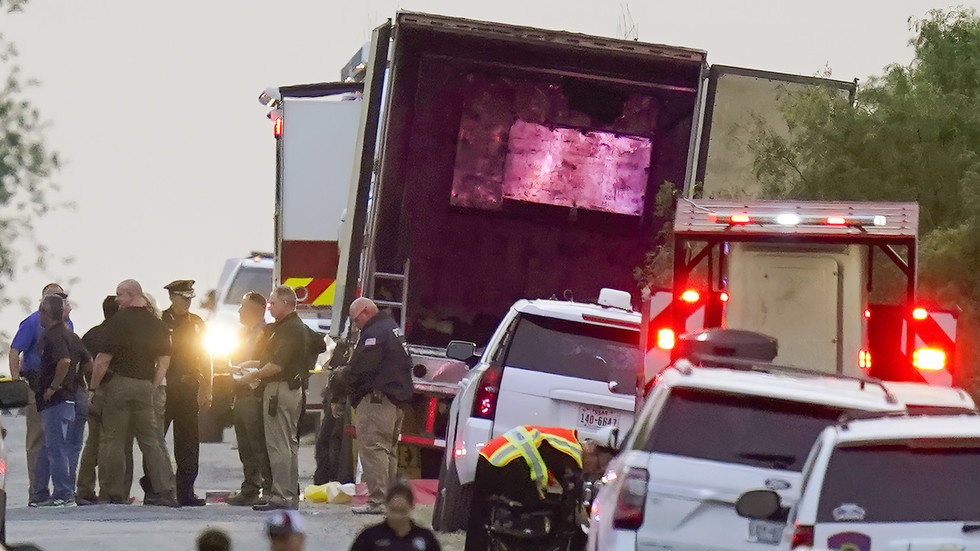[ad_1]
MISSION, Texas (Border Report) — A day after dozens of migrants died trapped in a trailer in San Antonio, U.S. Border Patrol agents took reporters to the South Texas border for a “safety day” where they conducted rescue simulations.
“Unfortunately, yesterday we saw a cruel example of the realities these desperate human beings face when they place their lives literally in the hands of criminals who care less about what happens to them as their commodity,” RGV Deputy Chief Patrol Agent Joel Martinez said Tuesday. “Fifty people lost their lives and a dozen others are fighting for their lives after being placed in a tractor-trailer in San Antonio without any means of escape.”
“My concern is also the children because you put somebody in the back of an 18-wheeler, or a car for that matter, it’s just terrible and the heat is multiplied by an umpteenth amount because it’s all sealed,” Martinez said.

Rescuing migrants from a trailer wasn’t part of Tuesday’s exercises, which included a riverine rescue on the Rio Grande, and finding two migrants lost in the thick South Texas brush, including a teenager separated from her mother.
The message Martinez said needs to filter south is for migrants not to try to come north.
“To bring awareness to the dangers that migrants face every day when they decide to take the perilous journey into the United States via the networks of criminal smuggling organizations,” Martinez said. “A smuggler’s No. 1 priority is to maximize profits by whatever means necessary, even if that means endangering vulnerable individuals.”


Several different types of Border Patrol units participated in rescue exercises on June 28, 2022, south of Mission, Texas. (Sandra Sanchez/Border Report photos)
The thick brush, quick-sand-like ground, dangerous wildlife, high humidity and triple-digit temperatures in the Rio Grande Valley of South Texas often leave migrants stranded and unaware of their location or how to get help after they cross from Mexico.
Since October, agents in the Rio Grande Valley Sector have made 913 rescues — that’s more than the 677 rescues they made in all of Fiscal Year 2021.
They have also helped to identify the remains of 57 migrants out of 87, agents said.

In one simulation, a woman triggered a rescue beacon — one of hundreds of beacons that U.S. Border Patrol have put up throughout the Rio Grande Valley border. There are also countless signs telling migrants where to go for help and to find a beacon, agents said.
In the exercise, she was diabetic and needed fluids in the field as the unrelenting sun beat down on the dirt road on which she sat. She told agents she had lost her 16-year-old daughter who had crossed with her.
Agents from the elite Border Patrol Search, Trauma, and Rescue, or BORSTAR unit, as well as a K-9 unit, drone and ATV unit, were dispatched to find the girl.
It took the teams about 15 minutes — which felt a lot longer in the intense heat and brush — to locate the girl lying in a dense field.
They moved her under a tree and put an IV line in. Then BORSTAR agents carried her on a stretcher for about a mile to an awaiting helicopter that extracted her.
Border Patrol Agent Milton Moreno said the rescue beacons are a lifesaver.
“A rescue beacon is activated and sends a signal to our dispatch, our communication center the operator relays that information and dispatches the agent. That equipment has a microphone and also a camera so we can see what’s going on,” Moreno said.

In another simulation, Border Patrol riverine agents rescued a drowning migrant who fell out of a raft while trying to cross the Rio Grande from Reynosa, Mexico.
“Dame tu mano. Dame tu mano. Calmate!” (Give me your hand. Give me your hand. Calm down!” agents in the boat yelled in Spanish to the man as they lifted him from the murky and dangerous water.

Border Patrol Riverine Unit Supervisory Agent Joe Barrios said agents aren’t always on the river at the right spot when someone falls in, and usually they are outnumbered with large groups, including children, for whom they scramble to rescue.
“In a real-life scenario we don’t know how far our riverine units are compared to where the incidents are occurring and when they do arrive you’re not dealing with just one subject at times, you’re dealing with a whole raft that’s overfilled. And a raft that isn’t in pristine conditions. And it has patches or it just can’t handle the amount of people on that raft. It’s a dangerous situation that involves adults and children and at times infants,” Barrios said.
“In that environment, imagine you have people going over, you have children going under,” he said.
Sandra Sanchez can be reached at Ssanchez@borderreport.com
[ad_2]
Source link












